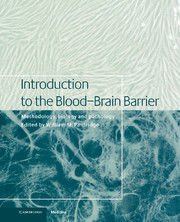Book contents
- Frontmatter
- Contents
- List of contributors
- 1 Blood–brain barrier methodology and biology
- Part I Methodology
- 2 The carotid artery single injection technique
- 3 Development of Brain Efflux Index (BEI) method and its application to the blood–brain barrier efflux transport study
- 4 In situ brain perfusion
- 5 Intravenous injection/pharmacokinetics
- 6 Isolated brain capillaries: an in vitro model of blood–brain barrier research
- 7 Isolation and behavior of plasma membrane vesicles made from cerebral capillary endothelial cells
- 8 Patch clamp techniques with isolated brain microvessel membranes
- 9 Tissue culture of brain endothelial cells – induction of blood–brain barrier properties by brain factors
- 10 Brain microvessel endothelial cell culture systems
- 11 Intracerebral microdialysis
- 12 Blood–brain barrier permeability measured with histochemistry
- 13 Measuring cerebral capillary permeability–surface area products by quantitative autoradiography
- 14 Measurement of blood–brain barrier in humans using indicator diffusion
- 15 Measurement of blood–brain permeability in humans with positron emission tomography
- 16 Magnetic resonance imaging of blood–brain barrier permeability
- 17 Molecular biology of brain capillaries
- Part II Transport biology
- Part III General aspects of CNS transport
- Part IV Signal transduction/biochemical aspects
- Part V Pathophysiology in disease states
- Index
8 - Patch clamp techniques with isolated brain microvessel membranes
from Part I - Methodology
Published online by Cambridge University Press: 10 December 2009
- Frontmatter
- Contents
- List of contributors
- 1 Blood–brain barrier methodology and biology
- Part I Methodology
- 2 The carotid artery single injection technique
- 3 Development of Brain Efflux Index (BEI) method and its application to the blood–brain barrier efflux transport study
- 4 In situ brain perfusion
- 5 Intravenous injection/pharmacokinetics
- 6 Isolated brain capillaries: an in vitro model of blood–brain barrier research
- 7 Isolation and behavior of plasma membrane vesicles made from cerebral capillary endothelial cells
- 8 Patch clamp techniques with isolated brain microvessel membranes
- 9 Tissue culture of brain endothelial cells – induction of blood–brain barrier properties by brain factors
- 10 Brain microvessel endothelial cell culture systems
- 11 Intracerebral microdialysis
- 12 Blood–brain barrier permeability measured with histochemistry
- 13 Measuring cerebral capillary permeability–surface area products by quantitative autoradiography
- 14 Measurement of blood–brain barrier in humans using indicator diffusion
- 15 Measurement of blood–brain permeability in humans with positron emission tomography
- 16 Magnetic resonance imaging of blood–brain barrier permeability
- 17 Molecular biology of brain capillaries
- Part II Transport biology
- Part III General aspects of CNS transport
- Part IV Signal transduction/biochemical aspects
- Part V Pathophysiology in disease states
- Index
Summary
Introduction
Cerebral microvessels possess properties that are typical for peripheral blood vessels, and in addition have properties of epithelial tissues (for review see Joó, 1996). In contrast to the peripheral vasculature, the endothelial cells of brain microvessels are connected by tight junctions and thus provide a permeability barrier between blood and brain interstitial fluid. This so-called blood–brain barrier (BBB) has properties in common with tight epithelia, i.e. an input resistance of 1–2 k φ/cm2, and different transport mechanisms in the luminal and antiluminal (brain-facing) membrane (Betz and Goldstein, 1986). The Na+/K+-ATPase is present in the antiluminal membrane and transports Na+ from inside the cell into the brain interstitial fluid in exchange for K+ ions (Betz et al., 1980). It has been demonstrated that an amiloride-sensitive Na+ influx as well as a Na+/Cl- co-transport, inhibited by furosemide, is present on the luminal side of the capillaries (Betz, 1983). This enables the transport of salt and water from the luminal to the brain side. However, K+ transport is mainly directed from the brain to the blood side (Hansen et al., 1977), and it has been concluded that the blood–brain barrier is involved in homeostasis of brain K+ concentration (Bradbury and Stulcová, 1970; Goldstein, 1979).
The development of the patch-clamp technique by Neher and Sakmann (1976) provided new possibilities to study ion transport across cell membranes. The cell culture technique has primarily been applied to study electrogenic transport systems in endothelial cells.
- Type
- Chapter
- Information
- Introduction to the Blood-Brain BarrierMethodology, Biology and Pathology, pp. 71 - 78Publisher: Cambridge University PressPrint publication year: 1998
- 2
- Cited by



